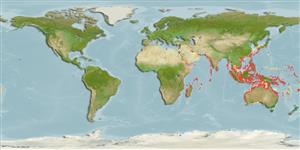Common names from other countries
Environment: milieu / climate zone / depth range / distribution range
экология
ассоциированный с рифами; пределы глубины 0 - 45 m (Ref. 800). Tropical
Indo-West Pacific: Red Sea to New Caledonia and Japan.
Length at first maturity / Size / Вес / Возраст
Maturity: Lm ? range ? - ? cm
Inhabits sandy and rubble areas at depths of 0 to 45 m. Feeds on algae and small invertebrates. Associated with Allopontonia iaini, Periclimenes colemani and Leutzenia asthenosomae (commensals) (Ref. 800). Its movement is assisted by non-venomous spines on the underside of its test (Ref. 85384).
Life cycle and mating behavior
половая зрелость | размножение | нерест | икра | Fecundity | личинки
Members of the class Echinoidea are gonochoric. Fertilization is external. Brooding is common, eggs are held either on the peristome, around the periproct or deep into the concavities on the petaloids. Life cycle: Embryos develop into planktotrophic larvae (echinoplateus) and live for several months before they sink to the bottom using their tube feet to adhere on the ground where they metamorphose into young urchins.
Основная ссылка
ссылки | координатор | соавторы
Schoppe, S. 2000. (Ref. 800)
Статус Красного Списка МСОП (Ref. 130435)
Статус СИТЕС (Ref. 108899)
Not Evaluated
Not Evaluated
Угроза для людей
Venomous
Использование человеком
| FishSource |
инструменты
дополнительная информация
Возраст/Размеры
рост
Зависимость между длиной и массой тела
Зависимость между длинами
морфология
личинки
численность
ресурсы в Интернет
Estimates based on models
Preferred temperature
(Ref.
115969): 22.3 - 29, mean 27.8 (based on 1114 cells).
Категория цены
Unknown.
